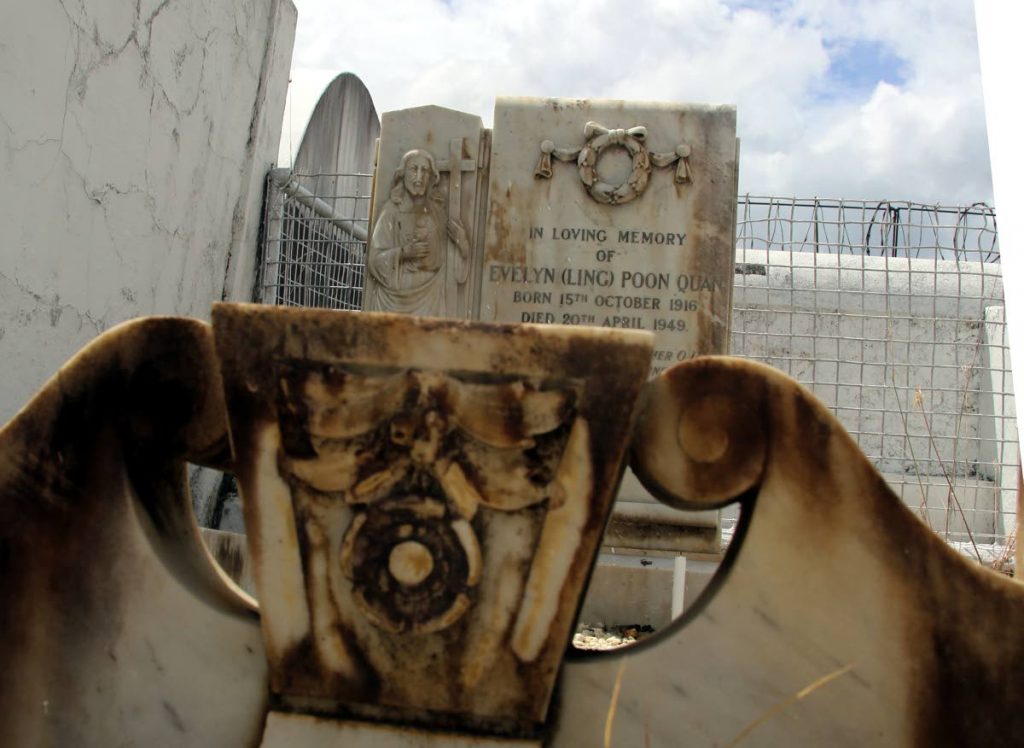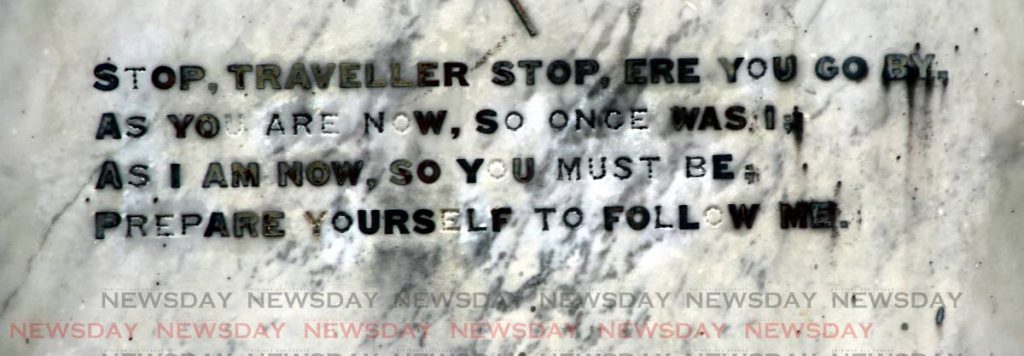Lapeyrouse, cemetery keeper of TT’s history

SOME of the structures are haunting even under the beating midday sun, with broken stained glass, sawn-of railings and shattered altars, reflecting the decades of vandalism that have plagued Lapeyrouse Cemetery, Port of Spain.
The National Trust organised a tour last Tuesday for about 30 people. The tour was oversubscribed, and the trust plans to repeat it.
Lapeyrouse remains a timeless ode to the first and multiple successive generations of Trinidad’s founders.
It is filled with the remains of an incredible diversity of social and ethnic groups, such as Chinese and Venezuelan migrants, who account for a surprisingly high ratio of graves.

Lining several streets are Chinese graves and tombs, with the Aleong family’s large white structure an appropriate representation of the dominating Chinese presence.
There is no shortage of Portuguese, French, Corsican, German, British and other distinguishable names scattered throughout.
There are magnificent tributes to the early Syrian and Lebanese arrivals, one of which was best represented by the Nahous family’s elegant and prominent structure.
The tomb of famous legislator Sir Louis de Verteuil, who died in 19o0, a tour guide from the National Trust pointed out, is also a chapel. His vault and several others in the cemetery would have acted as a chapel, where services were held, with permission from the Catholic Church.

The earliest burial at Lapeyrouse is believed to be that of Jean Creteau, who died in 1745. This area was known as the Campo Santo, and land from various surrounding sugar estates was gradually added to it by the Cabildo, or Town Council. Among them was the estate of Picot de la Perouse, a French nobleman who was the first person to produce sugar in Trinidad, from 1787.
Many of the tombstones identify people who died in the mid to late 19th century, some telling dramatic tales, from the devastating yellow-fever epidemic in the 1870s and the preceding cholera outbreak of 1854 (those who died had to be buried a mass grave), to William Nichol, the country's first victim of a car crash in 1911.
The overpacked graveyard remains full of surprises, beauty, and sadness. There is hardly a better reflection of this country’s rich history than Lapeyrouse, but the cemetery is in mourning and its unkempt condition is an injustice to the national icons buried within.
William Hardin Burnley, Trinidad’s biggest slave owner and richest man, whose assets were greater than the colony’s budget, rests near the northwest corner of the graveyard, against the western wall.

Businessman William Gordon Gordon, who built Knowsley, inhabits an almost equally imposing mansion in death, which can be seen from outside the cemetery at the corner of Tragarete Road and Colville Street.
The vault has fared less well than his house: it has not escaped the vandals and the other questionable visitors, who have left behind empty bottles and broken open some of the vaults. Strewn with cups and other party supplies, the decrepit tomb regrettably epitomises Lapeyrouse in its current state.
At this time of year, there is also evidence of recent activity, as fresh flowers and candles can be seen even on the graves of some of the deceased who have been dead for many years.

Another surprise to the unwitting visitor was the discovery of the great 19th-century Trinidadian artist Michel-Jean Cazabon, who rests in as plain a burial site as you can imagine. Cazabon’s grave is a single lot, camouflaged behind other familiar, but less famous names. A most un-Cazabon-like copy of one of his paintings, copied onto the headstone, is nearly disguised by overgrown bush. Restored by Citizens for Conservation years ago, the grave is in a sorry state for a figure of his stature.
But there is beauty to behold at Lapeyrouse, unexpected turns and mind-boggling history lessons.
It’s still possible for it to be returned to its best, with much effort, and likely only with co-ordination between the National Trust and the Port of Spain City Corporation, which is charged with maintaining the cemetery.


Comments
"Lapeyrouse, cemetery keeper of TT’s history"